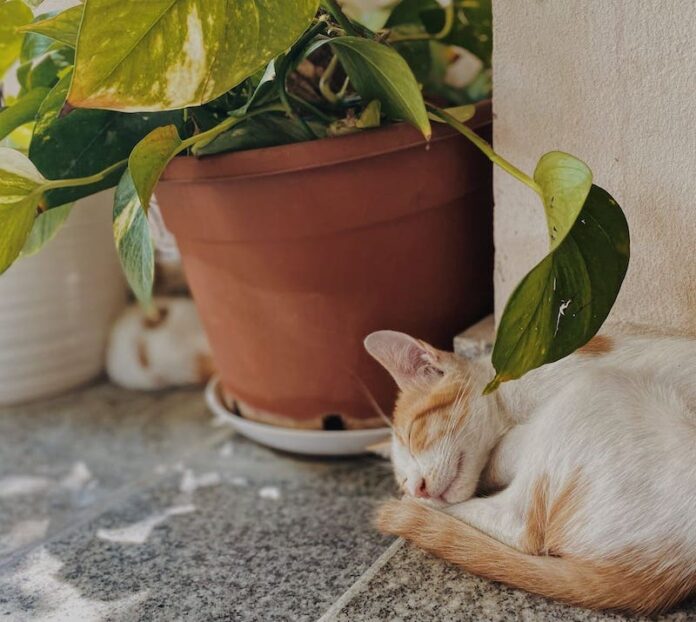Not all houseplants are created equal, and our pets would say the same too. Pet owners who are also plant-lovers should know a thing or two about the plants they keep in the same room as their furry creatures. Sadly, not many common plants are safe for cats and dogs. There are plants that can be extremely toxic to your cat or dog if ingested and could cause stomach cramps, seizures, diarrhea, and other serious intestinal issues.
In the past few years, rubber trees have become extremely popular for plant-lovers. Their shiny, dark green leaves remain their focal point and the plants can grow quite big. However, these common rubber trees are toxic to cats and dogs, and would not be ideal to have in the house.
The ZZ plant is also one that is toxic to cats and dogs. Pets can get mildly poisoned by it if ingested directly. Even if your pets are not even slightly interested in your plants, it’s still better to be safe than to be sorry. Sites like the ASPCA even provide lists of toxic and non-toxic plants so you can make sure to be 100% sure before you bring home a leafy baby.
If you’re a pet owner, you already know the cost of living of having a pet in NYC can be high, the last thing you want to do is take on more vet bills from emergency trips due to toxic plant consumption.
Pet Friendly House Plants
Here is a list of nine nontoxic plants that are safe for cats and dogs:
1.) Rattlesnake Plants
These plants are quite tricky to take care of, but with the correct nurturing, their foliage will impress you. This plant can grow up to 30 inches tall, and the leaves vary in waviness and various shades of green. The underside of the leaves are a reddish-purple, making it a rather beautiful plant if correctly cared for. Rattlesnake plants do best in indirect sunlight.
2.) African Violets
As the name suggests, African Violets are native to East Africa, originating from Kenya and Tanzania. These plants are actually not a type of violet, contrary to their name. The leaves are fuzzy and round, and when the flowers bloom, they can come in different colors like white, purple, or blue. These grow best in bright, indirect sunlight.
3.) Parlor Palms
As one of the most densely sold plants in the world, these are a great addition to a plant collection. They do well in non-tropical environments but the look of it adds a tropical touch to the home. They grow well in bright, indirect sunlight.
4.) Waffle Plants
This delightful small house plant can be the perfect addition to a home office. The bright, purple foliage is pretty while the leaves are a bit crinkly, like the texture of a waffle. This plant is low-maintenance and thrives well in bright, indirect sunlight. In less light, it may lose some of the rich colorings it is known for.
5.) Spider Plants
Don’t let the creepy name fool you. Spider plants are safe and are also known as one of the most adaptable house plants that are easy to grow. A common display that is often seen in this plant is the browning leaf tips. However, it is normal for the plant to do this and nothing to worry about. This often results from too much fluoride in the water. The plant gets the name from the spider-like plants that dangle from the mother like a spider on a web. Spider plants grow the best in bright, indirect sunlight and do better in cooler temperatures.
6.) Cast Iron Plant
This plant can reach up to 2-3 feet and presents itself with dark green foliage and shiny, lush leaves. Its stunning look can bring a calmer feel to a space as well as being a near-indestructible houseplant. It is a slow grower and can survive even in deep shade with virtually no light. It’s one of the perfect low-light plants that are safe for cats and dogs.
7.) Boston Fern
The Boston Fern is a low-maintenance plant that looks good on the floor or even hanging. The ferns are perfect for kitten batting and are safe for a nibbling puppy. This plant requires a spot that is cool and has low light. Take note though, that this plant does require higher humidity. If you live in a dry environment, make sure to keep a humidifier nearby to make sure the plant will survive.
8.) Baby’s Tears
This plant is often mistaken for a type of moss, but it actually comes from the nettle family. Its leaves are fine and round attached to short stems. Baby’s Tears are easy to grow for beginners but require more attention than most of these plants on this list. They thrive in low-light environments and can be grown indoors or outdoors (under certain conditions).
9.) Prayer Plant
The prayer plant is a tropical plant that is known for its colorful leaves. They are a mixture of green, red and yellow, with a distinctive pattern that runs down the leaf. Its name comes from the way the leaves lay flat during the day and fold up at night like prayer hands. The slow-growing plant prefers bright, indirect sunlight.
Need more houseplant ideas? Check out the CitySignal Plants Page!


